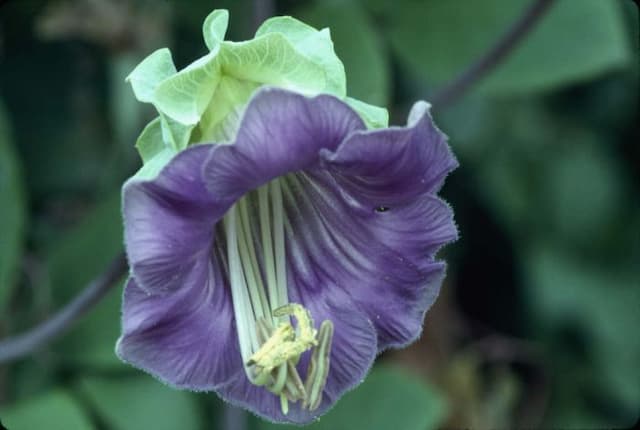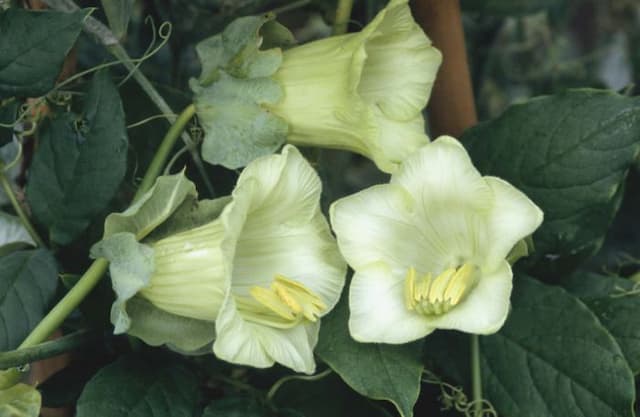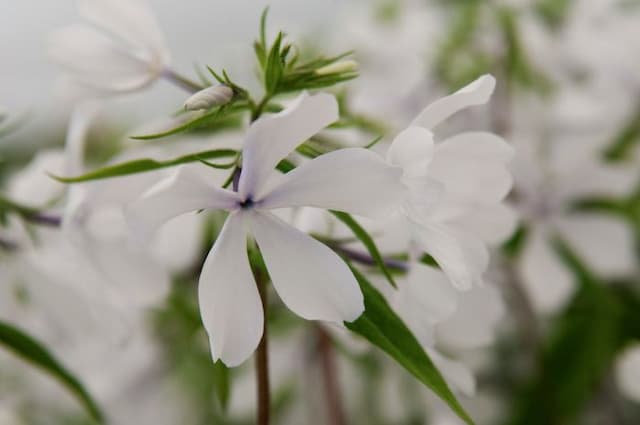Garden Phlox Phlox paniculata 'Othello'

ABOUT
Phlox paniculata 'Othello' is a vibrant flowering perennial known for its richly colored blooms and lush foliage. Each plant produces clusters of flowers that come together in a showy, rounded dome shape. The blossoms themselves are a deep shade of purple with a small, darker eye at the center that provides a striking contrast to the lighter color of the petals. The petals have a slightly crinkled texture, adding a sense of depth and richness to the overall floral display. The leaves of 'Othello' are deep green, providing a perfect backdrop to highlight the vivid purples of its flowers. These leaves are oblong, with a smooth edge, and they taper to a pointed tip. They are arranged oppositely along the stems, creating a lush, full appearance. The contrast between the dark foliage and the purple blooms makes this phlox variety particularly striking in garden settings. Additionally, as a cultivar of Phlox paniculata, 'Othello' has a sturdy and upright habit, which helps to showcase the dense flower heads at the top of the stems. The overall picture is one of a delightful spot of color that can make an eye-catching statement in a border or as part of a floral arrangement.
About this plant
 Names
NamesFamily
Polemoniaceae.
Synonyms
Garden Phlox, Summer Phlox, Perennial Phlox, Tall Phlox.
Common names
Phlox paniculata 'Othello'.
 Toxicity
ToxicityTo humans
Garden Phlox is not known to be toxic to humans. It is not associated with any significant toxicity that would result in severe poisoning or death if ingested. As with any plant, individual allergies or sensitivities are possible, and it is generally recommended to avoid eating ornamental plants.
To pets
Garden Phlox is not considered toxic to pets. It does not contain any known toxins that would typically harm cats, dogs, or other domestic animals if ingested. However, as with any non-food plant, ingestion in large quantities may cause gastrointestinal upset such as vomiting or diarrhea due to the fibrous plant material, which is not a part of the typical diet for pets.
 Characteristics
CharacteristicsLife cycle
Perennials
Foliage type
Deciduous
Color of leaves
Green
Flower color
Red
Height
2-3 feet (60-90 cm)
Spread
1-2 feet (30-60 cm)
Plant type
Herb
Hardiness zones
4
Native area
North America
Benefits
 General Benefits
General Benefits- Attractive Flowers: Phlox paniculata 'Othello' blooms with stunning deep red-purple flowers that add aesthetic appeal to gardens.
- Pollinator-Friendly: The flowers attract bees, butterflies, and other pollinators, promoting biodiversity.
- Fragrance: The flowers emit a pleasant fragrance, which can create an enjoyable sensory experience in the garden.
- Long Blooming: Summer Phlox has an extended blooming period, providing color and interest in the garden throughout the summer months.
- Cut Flowers: The blooms make excellent cut flowers for vases and floral arrangements, adding beauty indoors.
- Garden Structure: Summer Phlox provides vertical interest in garden beds and borders with its tall flower spikes.
- Ease of Growth: It is a hardy perennial that is relatively easy to grow and maintain in a range of temperate climates.
- Variety: The species offers a range of cultivars with different colors and heights, allowing for diverse garden design.
 Medical Properties
Medical PropertiesThis plant is not used for medical purposes.
 Air-purifying Qualities
Air-purifying QualitiesThis plant is not specifically known for air purifying qualities.
 Other Uses
Other Uses- Phlox paniculata 'Othello', commonly known as Garden Phlox, can be used as a natural dye source for fabrics, providing soft shades of pink and violet depending on the mordant used.
- Garden Phlox leaves are sometimes incorporated into potpourri mixes for their attractive shape, adding texture and green hues to the blend.
- The dense clusters of Garden Phlox flowers can be used in flower pressing, often retaining color and shape, ideal for crafting bookmarks or decorative cards.
- These flowers are suitable for the practice of floragraphy, the communication of secret messages through the choice and arrangement of flowers, where they could symbolize unity or sweet dreams.
- Stalks of Garden Phlox can be woven into small wreaths or garlands when fresh and pliable, to be used as natural decorative elements in rustic themed events.
- Dried Garden Phlox flowers may serve as embellishments in candle making, pressed onto the surface of handcrafted candles for aesthetic enhancement.
- A live clump of Garden Phlox can be used as a centerpiece in garden art, setting a color theme for surrounding plantings or sculptures.
- Children might use the tall stems and flower heads of Garden Phlox to practice creating miniature bouquets for dolls and small vases.
- Bundled and dried stems of Garden Phlox, when trimmed, could serve as a natural bristle brush for dusting delicate household items.
- The mildly fragrant flowers of Garden Phlox can be used in homemade perfumes or scented sachets to provide a subtle, floral aroma.
Interesting Facts
 Feng Shui
Feng ShuiGarden Phlox is not used in Feng Shui practice.
 Zodiac Sign Compitability
Zodiac Sign CompitabilityGarden Phlox is not used in astrology practice.
 Plant Symbolism
Plant Symbolism- Harmony: Phlox paniculata 'Othello', commonly known as Tall Garden Phlox, features clusters of flowers which represent unity and the blending of hearts, making it a symbol of harmony and balanced relationships.
- Proposal: With its romantic connotations, the Tall Garden Phlox often signifies a proposition or an offering of one's heart to another, embodying the idea of proposing love or marriage.
- Sweet Dreams: In the language of flowers, Phlox can signify 'sweet dreams', which reflects the plant's traditional use in bouquets meant to express the wish for pleasant dreams and a peaceful night's sleep.
- Agreement: The Tall Garden Phlox also symbolizes agreement, perhaps due to its individual flowers uniting to form a harmonious whole, suggesting a consensus or accord among different parties.
 Water
WaterGarden Phlox should be watered deeply once a week, providing about one inch of water which equates to approximately 0.623 gallons per square foot. During hot or dry periods, increase watering to twice per week. Ensure the soil is moist but not waterlogged, and water at the base of the plant to keep the foliage dry and prevent mildew. During the winter or in cooler climates, reduce the watering frequency as the plant's growth slows down and its water requirements decrease.
 Light
LightGarden Phlox thrives in full sun to partial shade. The best spot for planting Garden Phlox 'Othello' is an area that receives at least six hours of direct sunlight per day. However, in particularly hot climates, providing some afternoon shade can help protect the plant from excessive heat stress.
 Temperature
TemperatureGarden Phlox prefers temperatures between 60 and 90 degrees Fahrenheit. It can survive minimum temperatures of around 40 degrees Fahrenheit. Ideally, maintain a consistent environment as extreme fluctuations can stress the plant.
 Pruning
PruningPrune Garden Phlox in early spring to promote vigorous growth and improve air circulation. Deadhead spent flowers to encourage a second bloom. Cut back the plant after flowering has finished in late summer or fall to maintain shape and overall health. Pruning during cool days can help prevent stress on the plant.
 Cleaning
CleaningAs needed
 Soil
SoilGarden Phlox requires well-drained soil with a pH range of 6.5 to 7.0. A good mix would include loam, compost, and perlite to ensure adequate drainage and fertility. Amend with organic material to enrich the soil.
 Repotting
RepottingGarden Phlox, a perennial, does not require frequent repotting. It is typically planted in the ground and divided every 3 to 5 years to maintain vigor and flower production.
 Humidity & Misting
Humidity & MistingGarden Phlox thrives in moderate humidity conditions but is quite adaptable and does not require any special humidity adjustments for optimal growth.
 Suitable locations
Suitable locationsIndoor
Place in a bright spot, ensure good air flow.
Outdoor
Full sun to partial shade, rich moist soil.
Hardiness zone
4-8 USDA
 Life cycle
Life cyclePhlox paniculata 'Othello', commonly known as Garden Phlox, begins its life as a seed, which, once sown in fertile, well-draining soil and exposed to proper conditions, germinates to produce a small seedling. The seedling grows into a vegetative state, developing a sturdy stem and lance-shaped green leaves, during which time it will establish a robust root system. As it matures, the plant enters the flowering stage in mid to late summer, showcasing dense clusters of fragrant deep red-purple blossoms that attract pollinators like bees and butterflies. Following pollination, the flowers produce seed capsules that contain numerous tiny seeds, completing its reproductive cycle. Once the blooming period is over, the plant may undergo a period of senescence, where the above-ground parts die back with the approach of autumn, especially in colder climates, while the roots or lower stem parts survive to regrow the next spring. This perennial can also be propagated by division of the root clumps in early spring or fall, thus continuing its life cycle for several years.
 Propogation
PropogationPropogation time
Early Spring
Propogation: Phlox paniculata 'Othello', commonly known as Garden Phlox, is most commonly propagated by division, which is ideally done in early spring or early fall. To propagate by division, dig up a mature clump of phlox and gently separate the plant into smaller sections, each with several shoots and a healthy amount of root system. Replant the divided sections at the same depth they were originally growing, spacing them about 18 inches (approximately 46 centimeters) apart to allow for air circulation and growth. Water the new transplants well to help establish them. This method of propagation ensures that the new plants will be true to the character of the 'Othello' variety, maintaining its distinctive dark purple blooms and robust growth characteristics.









